The Surprisingly Practical Reason Behind Doctor Who's TARDIS Design
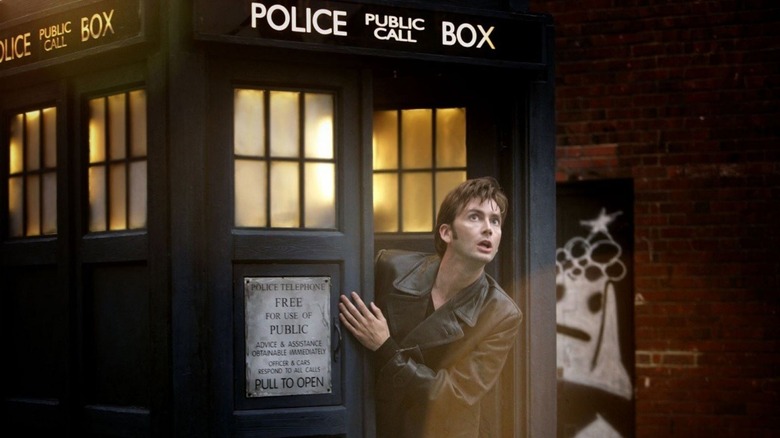
Regardless of whether you're a "Doctor Who" fan, you must know about the TARDIS — the blue police box that can travel through space and time, and is bigger on the inside. The TARDIS is a mainstay of "Doctor Who" and perhaps the sci-fi show's most recognizable object; it is a time travel device used by the show's Time Lord to go on his adventures. Whenever anyone steps into the TARDIS, their jaws usually drop upon seeing how large it is on the inside.
But have you ever wondered why the TARDIS (an acronym for Time and Relative Dimension in Space) looks the way it does? Why it looks nothing like a car that speeds up to the point of time travel, a cosmic treadmill, or a flying, UFO-resembling device? It's just a regular old police phone booth. The Doctor's adventures span across eras — from the days when Vincent Van Gogh was a disgraced painter to the end of the world. So why not give him a cooler-looking spaceship?
There's actually a pragmatic reason why the time-traveling protagonist uses a police phone box to jump back and forward in time.

Budget is a universal issue, apparently
"Doctor Who" was imagined as a different show altogether — it was meant to be an educational family program. The main characters were intended to be science and history teachers, and they'd tell stories entirely based on historical events sans aliens and the possibility of time-traveling across eras.
The TARDIS was conceived as an object that would take the form of an article belonging to the period the episode would focus on. For instance, in an episode that took viewers to Ancient Greece or Egypt, the TARDIS would be redesigned as a column (representing Greek's pioneering architectural style) and a sarcophagus (a stone coffin), respectively. Part of me can't help but envision how hilarious it would be to see the Doctor emerge from a coffin ... it's wild to imagine what we could've had.
Anyway, when the show's budget was being calculated, it was discovered that giving the TARDIS a make-over for every episode was expensive and not at all becoming. So the makers of "Doctor Who" came up with a strategy to give the time-traveling machine a suitable appearance — one that was inexpensive and had the potential to evolve into something symbolic for the show. Thus, the police telephone box was born!
All about the malfunctioning chameleon circuit
In the "Doctor Who" universe, the TARDIS was equipped with a "chameleon circuit," allowing it to hide in plain sight. The time machine blended in with its surroundings. So, when the show was released in 1963, the time travel machine took the form of one of London's many police phone boxes.
In a mini-episode from the season 5 DVD box set that explains the workings of the TARDIS, the Doctor explains (via Den of Geek ):
"Every time the TARDIS materializes in a new location, within the first nanosecond of landing, it analyzes its surroundings, calculates a twelve-dimensional data map of everything within a thousand mile radius, and determines which outer shell would blend in best with the environment... And then it disguises itself as a police telephone box from 1963."
Naturally, with the popularity of "Doctor Who" today, the budget isn't a problem anymore. They could transform it into a spaceship or a car ... or a coffin. But despite looking like a regular old police telephone booth, the TARDIS has become one of the most popular sci-fi time machines of all time. And now the ironic thing is, the police telephone boxes (once an incredibly common sight in the '60s) have all but disappeared from the streets of London, and the anachronistic blue box is now associated largely with "Doctor Who." The Doctor might regenerate now and then, so a new face may lead the sci-fi series, but the shape and form of the TARDIS remain the same.
- LATEST NEWS
- 60TH ANNIVERSARY SPECIALS
- 15TH DOCTOR
- TITAN COMICS
- IN OTHER WORLDS

- 60th Anniversary
- Classic Doctor Who
- Fifteenth Doctor
FEATURE: The Changing Face of Doctor Who’s TARDIS
60 years of doctor who means 60 years of the tardis. like the show itself, its changed and grown (oh my how it’s grown) but it’s always retained the same essentials.
We have a new TARDIS! (Tardis… tardis ) Sorry, there’s a bit of an echo in here. Because this set is huge . Yet in many ways it’s also a throwback to the very early days of Doctor Who . Blogtor Who is here with a brief history of time travel machines. Join us as we look at what’s changed, evolved, and crucially, stayed the same over sixty years of the show. From the very first console room to the latest model, it’s all here.

The 1963 original set the template, with its six sided console and central cylinder which rises and falls in flight becoming icons of the show
Peter Brachacki was the BBC designer who conceived the original TARDIS set despite, infamously, not even wanting the job. Indeed, he very quickly found a way to make his excuses and leave the assignment. He didn’t even make it to the second episode. Yet his design for the Doctor’s ship is as embedded in Doctor Who’s appeal as the Daleks. Could a regular science fiction bridge with desks and seats and individual control panels have ever captured the public imagination, must less kept them enthralled decades later? Crucially too, would it have been so infinitely flexible? As we’ll see, so long as designers observe certain fundamentals they can get as wild and imaginative with their dream set as they like. The result will still remain identifiably the TARDIS.
The importance of that flexibility came sooner than you may think. In the 1960s Doctor Who typically filmed in a single studio space, with all sets standing back to back in one room. Those facilities were often incredibly cramped and so there was no standing TARDIS set. Rather the crew only erected it as needed, and as little of it as possible too. But the visual identity of Brachacki’s six sided console was so strong that so long as it, and the roundel pattern on the wall, remained nobody questioned that this was the Doctor’s home.

A rare design misstep in The Time Monster saw a new design which only lasted one story
Though increasingly beaten up and patched together, the core elements of the original set remained for seven series. The original console itself (now revealed to be a mint green by the advent of colour television) making one final appearance in Third Doctor story Inferno . (The doors, however, remained for the show’s whole 20th century run). The following year, a whole new console debuted in The Claws of Axos . This time it was genuinely the white viewers had always imagined, but while a complete rebuild it was clearly designed to recreate the original as much as possible (give or take a simplification here or there). Soon after, a brave attempt to fiddle with the design of the roundels emphasised the strength of the original. Widely regarded as a failure, they disappeared without trace after their appearance in The Time Monster and the old type returned.

Season 14’s proto-steampunk look didn’t last long, but is still fondly remembered today
It was in Season 14 in 1977 though that the TARDIS got its biggest makeover to date. In fact, arguably, the dark, wood paneled room was the most revolutionary shake up ever. The console became little more than a pedestal, its strangely small selection of buttons hidden behind wooden panels, and not a time rotor (aka the uppy-downy-thing) in sight. All this plus stained glass windows, and a door hidden behind dark curtains over a small flight of steps. The set’s designer, Barry Newberry, reimagined the scanner too. No longer a small television in the corner, whether suspended from the ceiling or set against the wall, it was a huge affair more like a modern 50″ flatscreen than anything you could actually buy in 1970s Britain.
Yet, for all its diversions from the norm, many fans still remember this proto-steampunk console room fondly. It didn’t last however, as various issues required the return of the original console the next season, and with it the white room it sat in. However, the spirit of the Series 14 model lived on. Its scanner and columns were repainted and became part of the ‘old’ set, and even the stained glass roundels were painted over to pop up occasionally as parts of walls elsewhere in the TARDIS.

By the end of Tom Baker’s time in the TARDIS, the ship was looking increasingly in need of repair
Once again, TARDIS’ real life history, much like its in-universe equivalent, became one of running repairs unable to keep up with its steady disintegration. As switches and levers broke, the design was simplified to have less of them. Holes were roughly drilled into its surface to meet plot requirement, a slot for the core of the Key to Time here, a retractable control deck for the chameleon circuit there. Efforts to liven it up tended to involve nothing more revolutionary than colourful bits of tape. Worst of all, the time rotor now wobbled alarmingly while audibly struggling to reach its zenith. In fact, on occasion a member of the crew had to sit underneath to push the broken mechanism up and down by hand.

Doctor Who celebrated its 20th Anniversary with a new console that was glossier than any before it
But it was all change as the Fourth Doctor became the Fifth. For whatever reason, scenes set in the TARDIS became longer and more involved and we spent more and more time there. A consequence of that was the TARDIS corridors and other rooms became a world of their own. Where once the Doctor Who team might have decamped to a decommissioned hospital to portray the ship’s inner rooms, now they had a look consistent with the console room itself. The cloister room was added too, a stone version of the familiar design, with columns festooned with ivy. And with it, came the cloister bell, for the first time intoning its warning of terrible danger from the very heart of the TARDIS.
For the 20th anniversary in 1983, the TARDIS got the best present – an entirely new console. Its buttons may have been largely non-functional, but possibly for the first time the Doctor’s ship had so many screens, controls, and keyboards that it really did look like it bring you to eternity and back. The new time rotor was particularly magnificent, like a crimson model of Asgard rising and falling smoothly and silently. It remained in place for the rest of the 1980s, departing our screens with Doctor Who itself…

The TV Movie’s TARDIS can now be seen as a link between old and new, informing every design since
When Doctor Who returned in 1996 in the form of a TV movie filmed in Canada and co-produced with American backers, it was time for a whole new TARDIS. It was one of the main ways the movie distinguished itself as something more polished and expensive than before. Vast and cathedral like, it had exposed iron buttresses, an entire library, and bats in the cloister room. It also represents a link between old and new, with some of its biggest design innovations being carried over to the revived show.

A new century brought a new TARDIS, one that showed the battered Time War wounds the Doctor tried to conceal in himself
When Doctor Who exploded back onto our screens in 2005 we joined Rose Tyler as she stepped into the Police Box, and then circled it completely into disbelief before diving back in. The room she found herself in borrowed ideas from its immediate predecessor. The time rotor was now contained within a tube extending to the ceiling, while the interior rotor moved up and down to meet a twin descending from the roof. It also had buttresses gathered around the console, now in a coral like substance. But while its great dome seemed grander than ever, the general vibe was of a noble ruin. Surfaces were covered in grime, and controls were held together with random junk and hope. This was the post-Time War TARDIS, still wearing the scars of the battles it had been through and the destruction of Gallifrey.
It also imported an idea from the 1960s Dalek movies, with the Police Box doors now visible inside the console room. It’s a feature that all later designs would retain.

Massive, chaotic, and whimsical, Matt Smith’s original console room was the largest console room ever… until now
In 2010 Doctor Who went through its next regeneration as a show. New showrunner Steven Moffat would later admit that it was the arrival of a new writer, new star, and new companion all at once that inspired him to start a clean slate, with new titles and a new TARDIS too. Moffat had invented the idea of a ‘desktop theme’ as a throwaway gag in the charity minisode Time Crash. Now he fully committed to the bit. Here it was revealed that major changes to the TARDIS’ look weren’t the result of tireless work and engineering by the Time Lord, but the ship itself creating a whole new room as if by magic.
Matt Smith’s console room was even bigger than the one shared by Eccleston and Tennant, but more chaotically laid out. The time rotor now extended below the console into an antechamber beneath, with the console itself on a plaform. There were stairs leading here and there. And the predominant aesthetics were brass and whimsy. Like its immediate forerunner, this console feature bits and bobs among its controls. But the sink taps, old typewriters and reel to reel tape recorders seemed more like deliberate affectations than desperate attempts to keep the ship running.

The cluttered, lived in machine of the Twelfth Doctor quickly became many’s all time favourite
That beast of a console room lasted only two series. BBC Wales moved studio space and therefore the Eleventh Doctor got new digs. Designer Michael Pickwoad seized the opportunity to create an environment that utilised all the innovations of recent versions while embracing the classic era’s more clearly machine like look. It featured multiple levels and exits and entrances but in a more structured space. In place of coral or warm brass was cold grey metal. And the console itself was an eccentricity free zone. Dramatic, heavy levers were the order of the day instead. An extraordinary piece of design, it was fully enclosed and self-lighting and inspired many of
Perhaps best of all this TARDIS continued to evolve its entire time on screen. More traditional roundels appeared on the lower walls, and vents in the floor provided light and steam to add atmosphere. But best of all, when Peter Capaldi’s Doctor he arrived he brought with him a ramshackle collection of bookshelves, clutter, and even an electric guitar. The TARDIS hadn’t felt so much like someone’s home for decades.
No wonder even now it’s still regarded as perhaps the greatest console room of all. When an Instragram post showed it beginning to be taken apart, grown men and women wept.

The Thirteenth Doctor’s era introduced a new crystal cave style console room
Whatever had followed would have found it difficult to win fans over. As it was, the Thirteenth Doctor’s console proved one of the most controversial. Several ideas battled each other, with interlocking circles in heavy metals on one wall, an inner fence of roundel like lights on a light metal lattice, and crystal pillars lit from within looked distinctly like hollow plastic. A similar giant chunk of crystal dominated the console in place of a time rotor. The surrounding panels meanwhile returned to having mysteriously few instruments to actually fly a sophisticated time and space machine.
But probably most significantly, after several years of either multiple levels, high ceilings, or both, this felt the most like a television set since the 20th century versions. Like all TARDISes it had its fans, but relatively few would name it as their all time favourite.

Our brand new TARDIS is truly vast, with a look even colder and more clinical than Hartnell’s
Which bring us right up to date to the present day and the blinding white minimal futurism of the new TARDIS. The first thing to hit viewers was its huge space, several times larger than any before it. We have multiple levels once more, and enough space for even David Tennant to get out of breath running up and down its various ramps.
The second thing you notice, though, is how incredibly empty it is. You could place ever piece of bric and brac the Doctor’s ever collected, from the First Doctor’s lectern to the Twelfth’s record collection and they’d form nothing but a small pile in the middle of the lower floor. While all those ramps are roads to nowhere, terminating in the dead ends of closed air-lock type doors. For so vast a set, it seems to offer surprisingly few possibilities for interesting things the cast and crew can do with it.
The console itself brings back the floor-to-ceiling time rotor missing from the Whittaker set. Though seeming with no moving parts this time; the motion simulated by lights within it, similar to Capaldi’s. The controls have a similar satisfying chunkiness and complexity too. In some ways this central focus of the room feels like a natural successor the last set-but-one, only redecorated in pure monochrome rather than murky grey.

The Doctor and the TARDIS will travel on, both changing, always evolving… forever
The TARDIS has undergone massive changes, and will undergo them again. Some day even this now brand new set will be consigned to history. (Good luck getting it in a museum though). But however different it may be from era to era and set to set, thanks to Peter Brachacki’s iconic essentials, its essence is always retained. Much like the Doctor themselves. And much like Doctor Who .

Doctor Who’s 60th Anniversary specials conclude with The Giggle at 6.30pm GMT on BBC One in the UK and Ireland, and simultaneously on Disney+ worldwide
Share this:.
- Click to share on Twitter (Opens in new window)
- Click to share on Facebook (Opens in new window)
RELATED ARTICLES MORE FROM AUTHOR
Doctor who looks revealed in entertainment weekly, new fifteenth doctor novels announced from bbc books, doctor who: the celestial toymaker release date, leave a reply cancel reply.
Save my name, email, and website in this browser for the next time I comment.
Notify me of follow-up comments by email.
Notify me of new posts by email.
This site uses Akismet to reduce spam. Learn how your comment data is processed .
POPULAR POSTS
Interview: class is in greg austin and jordan renzo return to..., video of the day – flicks and the city, 2014, video of the day-doctor who-genesis of the daleks, 1975, popular category.
- Video of the Day 2202
- Doctor Who 1527
- Big Finish 832
- Classic Who on Big Finish 597
- Thirteenth Doctor - Jodie Whittaker 458
- Television 439
- Classic Doctor Who 377
- In Other Worlds 359

WHO IS THE DOCTOR
By Charles Apple The Spokesman-Review
Fifteen years ago today, a British TV series returned to American audiences after a lengthy absence. It’s been a favorite of sci-fi geeks ever since.
Originally a children’s show about a 1,000-year-old alien and his funny blue time machine, “Doctor Who” has lasted for more than half a century using wacky plots, gorgeous companions, creepy monsters ... and by replacing its lead actor every few years.
Here’s a look at Britain’s time-traveling Doctor and the 13 (well, actually 14 or or maybe 15, but who’s counting?) actors who have portrayed him – or her – over the 57 years since he – or she – set out on his — or her — journey.
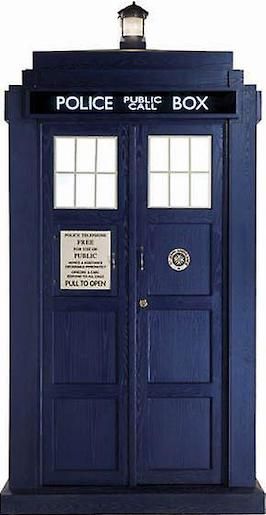
Q: How is it that 12 actors can play the same role?
A: When the original “Doctor Who” actor left for health reasons in 1966, it occurred to the producers: This man is an alien. Who’s to say he can’t just dissolve his body in a flash of special effects and emerge with a new face and a new personality? On the show, they call it “regenerating.”
Q: What’s the deal with the goofy blue phone booth?
A: That’s the Doctor’s time machine, the TARDIS: Time and Relative Dimensions in Space. It’s supposed to have a cloaking device that allows it to change shape to blend in with its surroundings. But during a visit to early 1960s London, the device got stuck in the shape of a police box and the quirky Doctor decided he liked it that way. Oh, and before you ask: Being a dimensional doorway, the TARDIS is larger on the inside than on the outside. Much larger.
Q: What’s with all the companions who travel with the Doctor? What kind of hanky-panky is going on in that little blue box?
A: Less than you’d think. The Doctor has usually been portrayed as an essentially asexual creature. Until fairly recently, that is, when he kissed a few companions and even married one – River Song, played by Alex Kingston, who had previously starred in the American TV show “ER.” The Doctor changed genders with his most recent “regeneration.” The new-and-improved female Doctor has, thus far, been asexual as well.
THE INCARNATIONS OF THE DOCTOR

WILLIAM HARTNELL
The first Doctor was a crotchety old man who kidnapped two schoolteachers and a girl who claimed to be his granddaughter. The contempt he seemed to have for humans softened over the years, however.

PATRICK TROUGHTON
The second actor to play the role gave the Doctor a strong comedic side but also was quick to leap to the aid of others. He developed a strong lack of respect for authority – which played well with late 1960s TV audiences.

JON PERTWEE
The third Doctor – who fancied ruffled shirts and capes – took a cue from James Bond movies, using technological gimmicks to protect Earth from alien invasions. The BBC began broadcasting the show in color.

The show reached new heights of popularity with Baker’s quirky, rapid-fire way of speaking and alien sense of humor. “What’s the point of being grown up if you can’t be childish sometimes?” this Doctor asked.

PETER DAVISON
From one extreme to the other: The youngest actor at the time to play the Doctor was constantly a victim, often being captured and rescued. Where Doctor 4 was otherworldly, this Doctor wore a very British cricket outfit.

COLIN BAKER
The sixth Doctor was played very much as a brash know-it-all. His companions found him abrasive. So did many viewers – the show’s ratings dropped dangerously low during a season-long courtroom-drama arc.

SYLVESTER McCOY
The seventh actor to play the role gave the Doctor a complex, layered personality: A buffoon but also a schemer, skilled at playing his enemies against each other. Nevertheless, the BBC canceled the show after 26 years.

PAUL McGANN
The BBC sold rights to the show to Fox, which made a TV movie in 1996. The new doctor was charming, romantic and heroic – but not quite enough to earn another TV series. The Doctor wouldn’t return for another nine years.


CHRISTOPHER ECCLESTON
The BBC’s revival of the show focused on action and heroics. The ninth Doctor played the role only one year, but his dynamic acting and the much-improved production values insured a second life for the franchise.
Where you’ve seen him: Eccleston was the blue-painted bad guy Malekith in “Thor: The Dark World.” Currently, he stars as a dodgy clergyman in the HBO series “The Leftovers” and as an eccentric father in the BBC’s “The A Word.”

DAVID TENNANT
The 10th actor to play the part gave the Doctor a cheeky, playful personality, but one that insisted on facing down evil. His description of time as “a big ball of wibbly-wobbly, timey-wimey stuff” sums up this Doctor well.
Where you’ve seen him: Tennant’s been on a roll since leaving the TARDIS behind. He starred as Alec Hardy in “Broadchurch” and as Crowley in “Good Omens.” He even voices Scrooge McDuck in the new “DuckTales” cartoon.

The 11th Doctor combined the dark side of the seventh Doctor, the quirkiness of the third and the manic energy of the 10th. This Doctor flirted with the human incarnation of his TARDIS and, yes, married companion River Song.
Where you’ve seen him: Smith played a minor role in “Pride and Prejudice and Zombies.” He’s also played the personification of SkyNet in “Terminator Genisys” and Prince Philip on Netflix’s “The Crown.”

A 50th anniversary episode that aired in 2013 featured a special incarnation of the Doctor that fell between his 8th and 9th selves.
Where you’ve seen him: Hurt was a master actor since the early 1960s. You might best know him as the first victim of the alien in “Alien.” He’s also been in “Hellboy,” “Tinker Tailor Soldier Spy,” “V for Vendetta” and as Mr. Ollivander in the “Harry Potter” movies.

PETER CAPALDI
Capaldi started his tenure as a stern, no-nonsense Doctor but quickly developed into an incarnation with a wicked sense of humor and a fondness for playing an electric guitar.
Where you’ve seen him: Before he was the Doctor, Capaldi was a doctor in “World War Z” and Cardinal Richelieu in the TV series “The Musketeers.” He won an Oscar for directing the short 1993 comedy film “Franz Kafka’s It’s a Wonderful Life.”
JODIE WHITTAKER
2018-Present
Although other characters in “Doctor Who” had been known to change genders – most notably, the Doctor’s nemesis known as the Master – The Doctor himself hadn’t done this until the Season 10 finale, when Capaldi’s Doctor became the enthusiastic and somewhat hyperactive incarnation played by Jodie Whittaker.
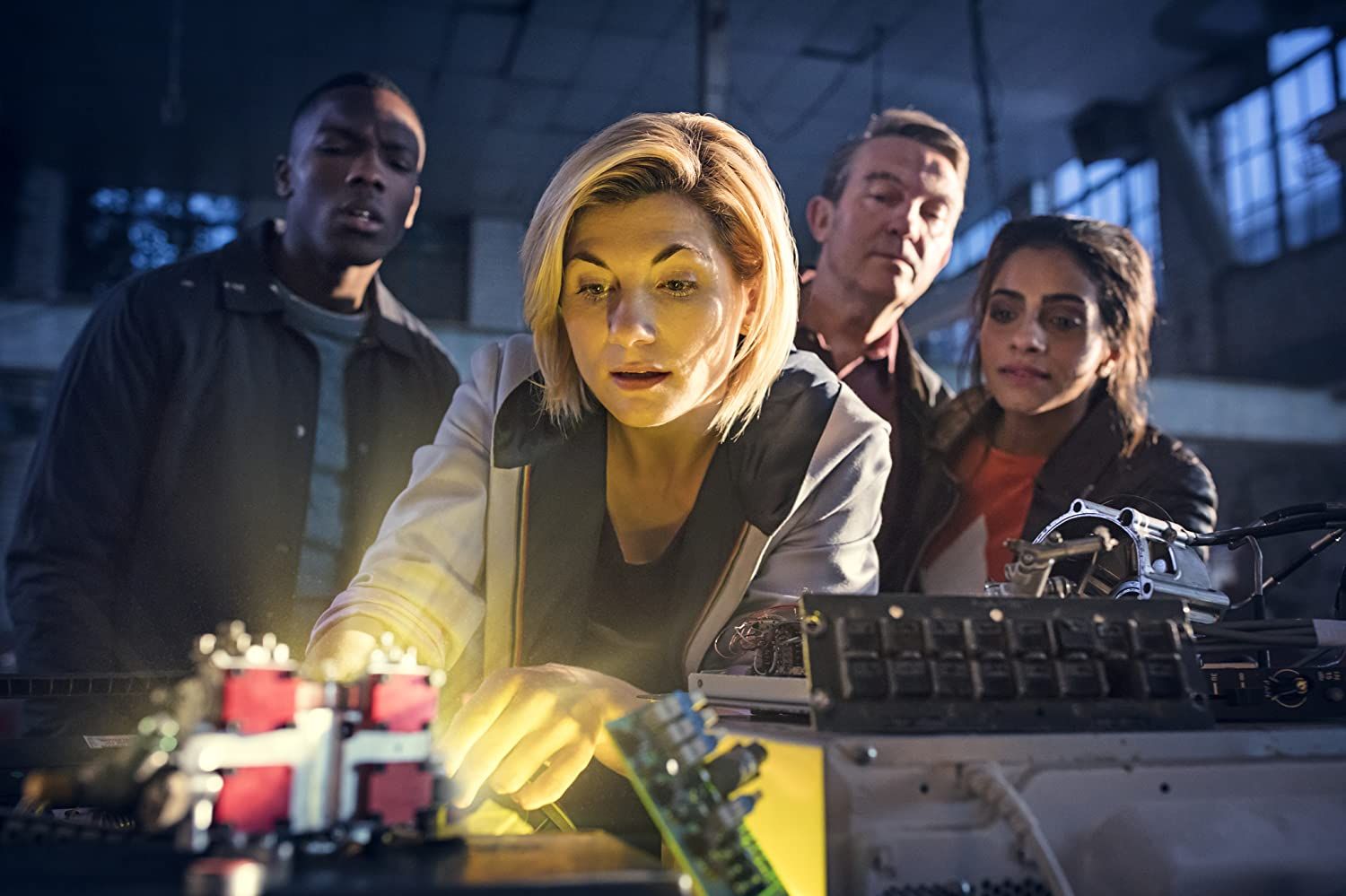
This doctor takes joy in showing her three companions around the galaxy and facing down the bad guys lurking behind every other planet. Among their early adventures: Traveling back to 1955 to witness Rosa Parks defy orders to give up her seat on a Montgomery, Alabama, bus.
Where you’ve seen her: Whittaker has appeared in a number of British TV shows – most notably, the crime drama “Broadchurch” starring former Doctor David Tennant.

Q: But wait a minute. Who is this?
A: That is British tour guide Ruth Clayton, played by Jo Martin. Who said in the fifth episode of the most recent season of “Doctor Who” – Spoilers, darling! – that she was, in fact, a previously unknown incarnation of the Doctor. And she has her own TARDIS to prove it.
It’s just another day, another scientific mystery for the Doctor...

The Who Shelf
Doctor who book & audio news, dalek mark iii travel machine: combat training manual.
One of the first things I covered on this blog was the TARDIS Manual back in 2018 and now the same team of writers and artists are back with the Dalek Combat Training Manual – a visual breakdown of the Doctor’s arch foes.
This combat manual is a collation of vital intelligence gathered by Time Lords over centuries. It is invaluable to anyone engaging the Daleks in battle. Know your enemy. Cover Blurb

The team of Richard Atkinson, Mike Tucker and Gavin Rymill are back together for this release with Atkinson and Tucker on writing duties and digital artist Rymill handling the visuals.
In particular, Rymill 3D modelling work made the TARDIS manual a particular treat, with details like Missy’s TARDIS console room. There’s no shortage of easter eggs here either, with insanely elaborate drawings and cross-sections, including the city on Skaro circa The Magician’s Apprentice and seemingly every model of Dalek ever depicted on screen, recreated in loving detail.

As frequent contributors to the worlds of Doctor Who, Atkinson and Tucker have lent their unique storytelling sensibilities to the book. As with the visuals, these have references to obscure Doctor Who trivia threaded neatly throughout. We also get the “field reports” – breakdowns of Dalek episodes both classic and modern.

It’s a credit to Tucker and Atkinson that they can retell old stories with the tone of military detachment while also making the narrative extremely compelling. As well as inventing backstory for the things we saw onscreen but went unexamined. I mean, where else are you going to find out why the Recon Dalek from 2019’s Resolution took some creative liberties with the design of his casing? Sure, it could just be that it was working with local materials. But isn’t it more fun to discover that he was emulating an early Dalek design adapted for reconnaissance? The book is full of little things like this.

If you liked the TARDIS Manual, this is exactly what you’d expect and exactly what you want. If, like me, you’re less interested in the cold data and more in narrative then this is a nifty accompaniment to Dalek stories with its background details. Either way, the love and effort that’s gone into this tome means it’s well worth checking out.
What’s your favourite Dalek variant? Let me know in the comments.
Leave a Reply Cancel reply
Your email address will not be published. Required fields are marked *
Notify me of follow-up comments by email.
Notify me of new posts by email.
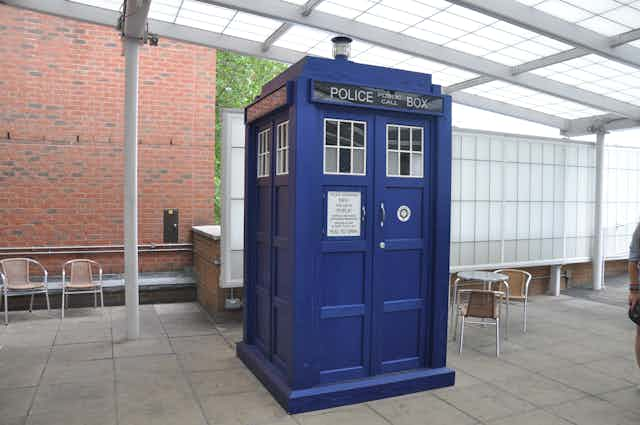
Here’s how Doctor Who’s time machine measures up with real instruments of space and time
Space Plasma Physicist, Queen Mary University of London
Disclosure statement
Martin Archer does not work for, consult, own shares in or receive funding from any company or organisation that would benefit from this article, and has disclosed no relevant affiliations beyond their academic appointment.
Queen Mary University of London provides funding as a member of The Conversation UK.
View all partners
There’s no denying that we’ve seen some absolutely staggering accomplishments in physics in the past year or so, particularly in our ability to measure space and time with unprecedented levels of detail. But being a lifelong “Whovian” excited about Doctor Who returning to our screens once again, I wondered how these accomplishments stacked up to those of the fictional Time Lords.
The crowning achievement of the Doctor has to be the TARDIS, the blue box from the show that’s bigger on the inside and allows the Doctor and his companions to travel “all of time and space, everything that ever happened or ever will” as Matt Smith’s eleventh Doctor once put it. But throughout the history of the show, the Doctor’s TARDIS has shown itself to be rather unreliable, regularly turning up at the wrong place or time. Given these faults we might think that the TARDIS isn’t quite what it’s cracked up to be .
While the show has featured many, often conflicting, descriptions of how the TARDIS works, the key to the Time Lords’ time travelling ability seems to be the “Eye of Harmony”, essentially a star in an eternal state of collapsing into a black hole. In terms of real science though, the same theory that predicted black holes – Einstein’s general relativity – has solutions which permit time travel (in fact one possible way of doing this has been given the name TARDIS).
Whether nature actually allows such solutions to exist is still an open debate among theoretical physicists , and even if time travel could happen we certainly don’t know how to build a time machine. So we’ll just have to compare the Doctor’s TARDIS with our best instruments of simply measuring time and space.
What we really need to compare here are these instruments’ relative precision. A simple way of thinking of this is as the ratio of the smallest thing you can measure with an instrument to the largest. In the case of a metre ruler that would be 1 millimetre compared to 1,000 millimetres (a metre), or simply one in 1,000.
Measuring space
In terms of measuring space our best ruler by far is advanced Laser Interferometer Gravitational-Wave Observatory (LIGO). Gravitational waves are mysterious ripples in the fabric of space and time that travel across our universe at the speed of light – stretching space in one direction and shrinking it in the direction that is at right angles. LIGO was the experiment that last year directly detected the minute changes in distances travelled by light beams , caused by gravitational waves.
These changes in distance are some 1,000-10,000 times smaller than the size of the nucleus of an atom, and they’re detected over a four-kilometre distance. That’s a level of sensitivity that’s up to one part in 10 23 – a huge number consisting of a one with 23 zeros after it: 100,000,000,000,000,000,000,000.
Now, considering the TARDIS’s playing field is “all of space”, it’s staggering that even when it turns up at the wrong place it simply manages to land on the right planet (usually Earth). The observable universe is some 10 27 metres in diameter while the Earth’s is a comparatively tiny 1.3m metres. So simply being able to find our planet within only the observable universe is a feat requiring some one in 10 70 relative precision. And that number only gets bigger when we consider how big the universe might extend beyond what’s actually visible.
Measuring time
When it comes to time, scientists have been developing new atomic clocks which are much better than the old Caesium ones that have been used to define what a second is. All these new clocks essentially count the number of waves of specific colours of visible light emitted by atoms – a unique property of each element. Our current best clock uses Ytterbium atoms and is stable enough to yield relative precision a little less than one in 10 18.
But how do you compare this to the TARDIS? As it covers everything that ever happened or ever will happen, we need to essentially find out when the universe will die to be able to make a comparison. It’s currently 13.8 billion-years-old, but that’s still a very long way ahead. Given our current understanding of the amount of matter and energy in the universe, it won’t be until some 10 100 years that all of the stars, planets and galaxies will have died, all protons and neutrons will have decayed and even all the supermassive black holes will have evaporated. This is what is known as the heat death of the universe .
Given that in the show, the TARDIS tends to turn up only a few years or a decade or so off the intended target, a ballpark figure for the TARDIS’s precision in time is around one in 10 100. So despite it seemingly looking a bit rubbish in the show from time to time, we’ve still got a long way to go before we can match it. This is certainly something I’ll be keeping in mind when watching the show.
- Science fiction
- Gravitational waves
- Atomic clocks

Sydney Horizon Educators (Identified)

Senior Disability Services Advisor

Deputy Social Media Producer

Associate Professor, Occupational Therapy

GRAINS RESEARCH AND DEVELOPMENT CORPORATION CHAIRPERSON

"I accept your offer of a massacre. Your blood shall soak our uniforms. Your bodies shall soften our steps"
An aggressive clone-warrior race from Sontar, who travel in spherical ships, the Sontarans were engaged in a war lasting many thousands of years with the Rutans. In pursuit of the advantage, Commander Linx of the Fifth Sontaran Battle Group tried to invade 13th century Earth, until repelled by the Third Doctor.
Later meetings with the Doctor saw the Sontarans invading the Time Lord home planet of Gallifrey, forcing the Sixth Doctor to build them a time travel machine, and trying to covert Earth’s atmosphere into one suitable for warrior cloning using the ATMOS machines. Sarah Jane Smith later encountered – and defeated – the last survivor of that invasion, Commander Kaagh.
A Sontaran by the name of Strax befriended the Eleventh Doctor and fought alongside the Time Lord and his allies at Demon’s Run. The diminutive warrior from the planet Sontar teamed up with Madame Vastra and a human by the name of Jenny Flint and accompanied the Doctor on numerous adventures.
The Doctor's most recent encounter with the Sontarans saw them at their most dangerous, as they exploited Earth's protected status from the Flux to conquer the planet across time. From a war fleet in contemporary Liverpool, to a one-sided battle of Sontarans versus the British army at 1855 Sebastapol, to a genocide involving the Lupari species, the Sontarans have never been so martial, brutal and short.
More from the Whoniverse
From the store.

The Doctor delivered to your inbox
Be the first to know about the latest Doctor Who products and updates.
How does time travel actually work in Doctor Who?
You can't rewrite history! (Except when you can.)
"Let me get this straight... a thing that looks like a police box, standing in a junkyard, it can move anywhere in time and space?"
"Quite so."
"But that's ridiculous!"
Time travel has been at the heart(s) of Doctor Who since the series' very beginnings. But the show's approach to exactly how it works, and what the rules of changing history are, has changed more times than the Doctor's face.
Ten years into the show's run, it was established that the Time Lords have their own Laws of Time, practically all of which the Doctor has broken over the course of his/her adventures: they include a strict policy of non-interference in the history of others, and a rule banning Time Lords from ever crossing over into their own time-stream (i.e. meeting their past self).
But those are all just self-imposed edicts. What are the fundamental rules of time travel, as far as Doctor Who is concerned? And do they make any sense? Let's find out.
"You can't rewrite history!"
In one of Doctor Who 's very earliest jaunts into history, 1964's 'The Aztecs', the first Doctor (William Hartnell) reprimands his companion Barbara (Jacqueline Hill) for planning to intervene in the Aztecs' practice of human sacrifice. "You can't rewrite history!" he insists. "Not one line!"
His words here are, of course, open to interpretation. When the Doctor says Barbara "can't" rewrite history, he could either be saying that the act is physically impossible – that time travellers cannot impact events in a way that would change their future – or arguing that she simply shouldn't interfere, because the results could be catastrophic.
Let's be generous and assume that it's the latter, because later Doctor Who makes it very clear that time can be rewritten. Well, sometimes.
The eleventh Doctor (Matt Smith) puts it in blunt terms in the 2010 episode 'Flesh and Stone': "Time can shift. Time can change. Time can be rewritten."
Events in the past can be changed, and this will directly affect the future. 'Pyramids of Mars', a fourth Doctor's outing (portrayed by Tom Baker) from 1975, provides us with a clear illustration of this, with companion Sarah Jane (Elisabeth Sladen) briefly returning to a version of 1980 that's been transformed into an apocalyptic wasteland by the time tinkerings of villain Sutekh in 1911.
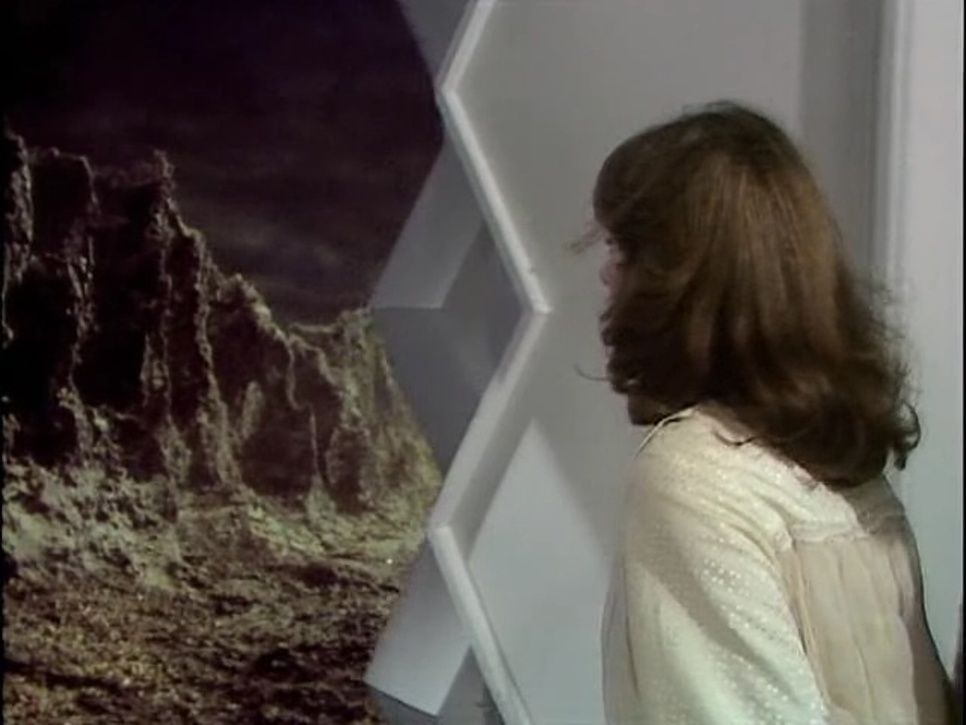
"Back to the Future... it's like Back to the Future!"
But what happens to the time-travellers themselves when history is altered?
Well, in 2007's 'The Shakespeare Code', the tenth Doctor (David Tennant) tells Martha (Freema Agyeman) that if the Carrionites succeed in taking over Earth in 1599, she would vanish – Back to the Future- style – because the future she's from would no longer exist.
If Prem lives, we're told, Yaz will blink out of existence.
However, other stories established that time travellers could survive certain changes to history, small alterations that don't impact their being born, since they were 'outside of time'. 'Flesh and Stone' even suggests that they'd be able to remember the original timeline – though the same year's 'Cold Blood' indicates that the more directly the change affects someone's life, the more difficult it is for that person to retain their memories.
Thus, Amy Pond (Karen Gillan) is able to remember the clerics swallowed up by the cracks in time in 'Flesh and Stone', but has to fight to remember her fiancé Rory (Arthur Darvill) after he's similarly written out of history in the later episode.
Still with us? Good.
How, though, does Doctor Who deal with that pitfall of all time-travel stories, the question of why 'the past' is sacrosanct, while 'the future' is malleable? If Barbara couldn't meddle with the Aztecs' history, why is it alright for the Doctor to overthrow the Dalek invasion of Earth in the 22nd century? That's still meddling with established events, right?
"Some things are fixed"
To tackle this problem, Doctor Who has introduced the idea of "fixed points" existing in history – sequences of events that must not be disturbed, or a thread will be pulled that could end up unravelling the universe.
"I'm history to you, [but] you saved me in 2008," Donna (Catherine Tate) challenges the tenth Doctor in 'The Fires of Pompeii'. "Why is that different?"
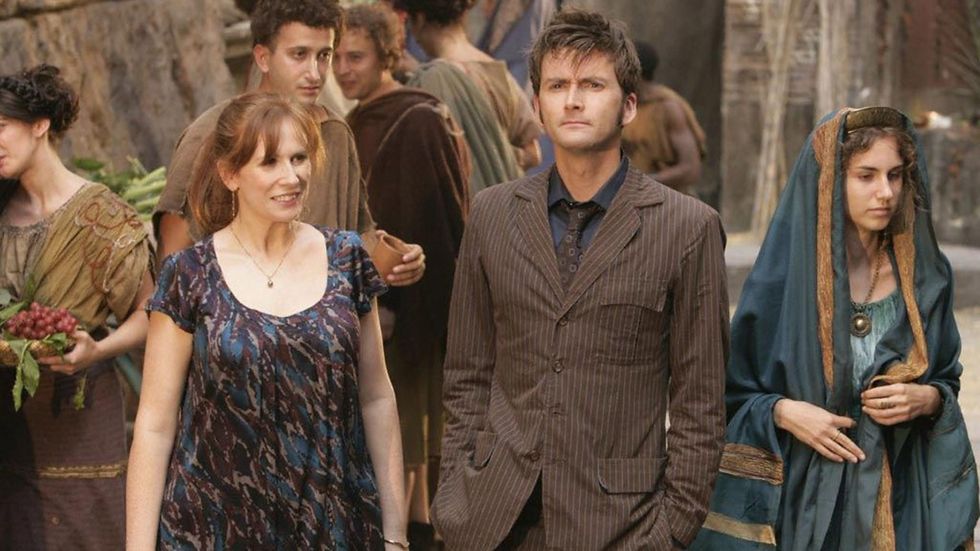
"Some things are fixed, some things are in flux," he responds, insisting that the 79 AD eruption of Mount Vesuvius which buried Pompeii and its surrounding cities must not be averted.
What is and isn't a fixed point tends to be entirely dependent on the demands of the story, but, importantly, we're assured that the Doctor is able to tell the difference. "I can see what is, what was, what could be, what must not," he tells Donna. "That's the burden of a Time Lord."
Conveniently, most of these fixed points tend to fall in Earth's history, which is how the show excuses fiddling with our future. (Though, to be fair, not all of them – the death of Bowie Base One's entire crew in 2009's 'The Waters of Mars' was also established as a fixed point in the year 2059, one that a reckless Doctor attempted and ultimately failed to defy.)
"It's more like a big ball of wibbly-wobbly, timey-wimey... stuff."
Clearly, like the TARDIS, the question of how time-travel works in Doctor Who is far more expansive than you might suspect.
But these are the essential points to remember...

Time isn't fixed, and you can rewrite history, every single line. In fact, simply by arriving in a new time and place, you've already made an impact.
For the most part, it's safe enough to make small alterations to the past – you can save the odd life here, overthrow the odd corrupt government there, so long as there's no major disruption to history.
It was implied, in episodes like 2005's 'The Unquiet Dead', that changing history was more perilous after the demise of the Time Lords in the wake of the Last Great Time War. This suggests that they were previously able to somehow paper over the cracks caused by minor changes to history, with the same year's 'Father's Day' revealing that they'd long held the Reavers – creatures who fed on time paradoxes – at bay.
However, major alterations should be avoided at all costs. (The Doctor appears to be the arbiter of what does and doesn't count as "major" – the annihilation of Earth in 1985, for example, would disrupt the web of time, as established in that year's 'Attack of the Cybermen'.)
You should also resist making significant alternations to your own personal history. While these might not affect the wider universe, they could impact on your memory, or even, in extreme circumstances, on your very existence.
Other than that, the only periods of history you shouldn't change at all are "fixed points", because any and all changes made to these will set off a chain reaction of sorts that will destabilise all of time.
It's a rather complicated lot of rules to remember. But essentially, any time-traveller in the Who-niverse would do well to mind the Doctor's advice from 'Demons of the Punjab': "Tread softly."
Want up-to-the-minute entertainment news and features? Just hit 'Like' on our Digital Spy Facebook page and 'Follow' on our @digitalspy Instagram and Twitter account .

.css-15yqwdi:before{top:0;width:100%;height:0.25rem;content:'';position:absolute;background-image:linear-gradient(to right,#51B3E0,#51B3E0 2.5rem,#E5ADAE 2.5rem,#E5ADAE 5rem,#E5E54F 5rem,#E5E54F 7.5rem,black 7.5rem,black);} Doctor Who

David Bradley set to return to Doctor Who

Doctor Who boss on Millie Gibson exit confusion
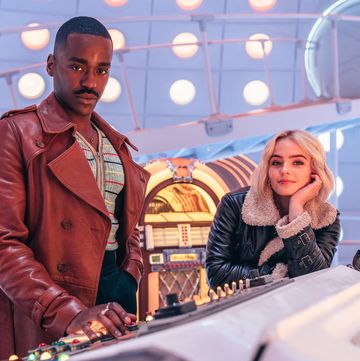
Doctor Who's Gatwa reveals monster he wants back

Doctor Who star on potentially leading Paradise

Bergerac being rebooted by Doctor Who writer

Doctor Who confirms details of brand new companion

David Tennant drama to stream on BBC iPlayer

Doctor Who confirms Jinkx Monsoon's role
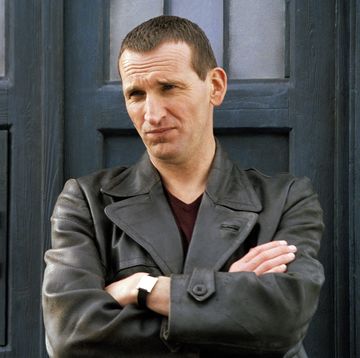
Doctor Who's Christopher Eccleston joins BBC show

Doctor Who’s Billie Piper on co-star's "hard time"

Doctor Who's Jinkx Monsoon teases season 14 role
- Become a teacher

Doctor Who: How Does the TARDIS Work? (Is Time Travel Possible?)
Episode #4 of the course Sci-Phi: Philosophy through science fiction by David Kyle Johnson, PhD
Einstein’s relativity suggests space and time exist as one entity, spacetime, and that spacetime can be warped and curved by mass and acceleration. This raises questions about whether we could alter the rate or direction in which we travel in time. And indeed, we could—and we can see how in one of my favorite sci-fi TV shows, Doctor Who .
Traveling to the Future
For example, massive objects like black holes warp spacetime in such a way that the closer you get, the slower time passes. And the effect can be quite pronounced. In the Doctor Who episode, “World Enough and Time,” a 400-mile-long spaceship is trying to reverse away from a black hole. While those on the top of the ship (closest to the black hole) age only a few hours, those in the bottom of the ship age years. (In the extra time they have, those in the bottom of the ship become the Doctor’s archenemy: the Cybermen.) Because the gravitational effects of a black hole increase exponentially as you approach it, such a disparity in time dilation is possible (if the black hole has the right mass).
Acceleration can also dilate time. According to relativity, if you were to travel away from the Earth at high speeds for decades, turn around, and then come back—by the time you returned, centuries would have passed on Earth. This method of time travel is used in classics like Planet of the Apes to facilitate travel into the future but could also be used to explain how The Doctor’s TARDIS allows him to travel both forward and backward in time. How?
Traveling to the Past
In short, if you use this method to time-dilate one end of a wormhole (a bridge between two distant spacetime points), you could travel into the future or the past by stepping into one end of the wormhole and emerging from the other. If the Doctor’s race—the Time Lords—figured out how to keep wormholes open (Kip Thorne says doing so would require “negative energy”), they could create a whole collection of them, call it a “time vortex,” build ships called TARDISes capable of traversing it, and thus travel anywhere and anywhen they wanted.
Now, this is all just theoretical, but the mere possibility of backward time travel seems to raise a logical paradox. As the Doctor’s companion Martha observes in “The Shakespeare Code,” with the ability to travel to the past, one could kill one’s grandfather before he sires one’s father. Such “self-annihilation” paradoxes are thought to entail that backward time travel is impossible. And contrary to the Doctor’s reply to Martha, one cannot solve them by simply not including grandfather killing in one’s time travel plans. It’s logically impossible for one to make it the case that one never existed, and logical impossibilities can’t even possibly be true.
Solving the Grandfather Paradox
But philosophers have concocted two ways to describe backward time-travel that makes self-annihilation impossible. The first is that of David Lewis, who suggests that backward time travel would not enable one to change the past; so if you traveled back in time and tried to kill your grandfather, you would necessarily fail. Indeed, since the actions you “will take” while in the past were already a part of the past before you hopped in your time machine, if you travel back to try to prevent something, you might find that you were actually the cause of it. In 50-plus years of Doctor Who , The Doctor has turned out to be the cause of everything from the extinction of the dinosaurs to the eruption of Mt. Vesuvius.
The second possible solution, belonging to Nuel Belnap and David Deutsch, suggests that traveling back in time would create an alternate timeline—one identical to the one you left up to the moment in the past to which you traveled. Any changes you make there will affect that timeline, but not the one you left. Thus, if you kill your grandfather, you won’t negate your own existence—but prevent the birth of someone with your DNA in the new timeline you created.
Now, one might argue that this looks more like “alternate universe creation” than time travel, but it also raises another question: Would a genetically identical doppelgänger of you in another universe actually be you ? This is a question about personal identity, and we shall use another long-running science fiction TV show— Star Trek —to explore it next lesson.
Recommended books
Doctor Who and Philosophy: Bigger on the Insid e edited by Courtland Lewis and Paula Smithka
Who Is Who? The Philosophy of Doctor Who by Kevin S. Decker
Share with friends
Screen Rant
Doctor who's first davros redesign confirmed as showrunner reveals reason for change to classic villain.
Doctor Who showrunner Russell T Davies addresses Davros' new redesign, revealing his motivations behind the classic villain's modernized update.
- Showrunner Russell T Davies confirms that Davros, the major villain in Doctor Who , has received a modern redesign to step away from stereotypes associating disabilities with evil.
- The decision to update Davros' appearance was made to reflect the changing world and move away from the character's original wheelchair-bound and scarred portrayal.
- This intentional design change respects past continuity while addressing criticisms and ensuring that everyone can see themselves in Doctor Who 's stories. Davros remains faithful to his character traits despite the updated look.
Major Doctor Who villain Davros' modern redesign is confirmed, as showrunner Russell T Davies addresses why the creator of the Daleks has received a design update for the next era of the show. The villain made his debut in the 1975 Fourth Doctor adventure "Genesis of the Daleks" portrayed by Michael Wisher, where he is established as the Kaled scientist behind the creatures that would ultimately become the Doctor's greatest foes. Davros would be a reoccurring foe across the classic era as David Gooderson and Terry Malloy would take on the role, while Julian Bleach has portrayed the character through the show's revival seasons.
While Doctor Who 's Children in Need short "Destination: Skaro" saw the Fourteenth Doctor (David Tennant) stumble into a paradox involving the Dalek's creation, audiences were also introduced to Bleach's portrayal of a younger, pre-injured Davros. Davies revealed during the new episode of Doctor Who: Unleashed (Later highlighted by Radio Free Skaro on Twitter) that the decision to move away from his original appearance was an intentional decision to step away from stereotypes associating disabilities with villainy.
The showrunner would then emphasize that this would be how Davros is seen now going forth, rather than relying on the post-attack appearance of the character.
We had long conversations about bringing Davros back because he's a fantastic character. Time and society and culture and taste has moved on, and there's a problem with the Davros of old in that he's a wheelchair user who is evil. And I had problems with that, and a lot of us on the production team had problems with that, of associating disability with evil, and trust me, there's a very long tradition of this. I'm not blaming people in the past at all, but the world changes and when the world changes, Doctor Who has to change as well. So we made the choice to bring back Davros without the facial scarring, and without the wheelchair, or his support unit, which functions as a wheelchair. I say this is how we see Davros now. This is what he looks like. This is 2023. This is our lens. This is our eye. Things used to be black and white, they're not in black and white anymore. And Davros used to look like that, and he looks like this now, and that we are absolutely standing by. I think, because it's Children in Need night. It's a night where issues of disability, or otherness, or being excluded from society come right to the front of the conversation. So of all the nights to make this change, I thought it was absolutely vital to do this, and I'm very, very, very proud of the fact that we have.
Davros' New Design Is Both A Considerate Update & Tribute To His Origins
Within the Doctor Who universe, Davros was left scarred and reliant on his travel machine following a Thal shelling attack on his laboratory on Skaro long before audiences would first meet him in "Genesis of the Daleks", with the character's design never straying too far from the concept across his following appearances. Due to this, Davros' later appearance has never been able to disassociate from the disabled villain tropes seen in older pieces of media, even as discussions surrounding these decisions have become more commonplace. However, through "Destination: Skaro", Davies has given the character a design that respects past continuity while laying the groundwork for permanent change.
While the light-hearted charity short offers a humorous explanation for the Daleks' plunger manipulator arm , the Doctor's comments on " timelines rupturing " suggest his intervention could have larger ramifications, perhaps allowing this younger Davros to subvert his fate or appear from this specific point in time. The younger Davros' speech also firmly ensures that his twisted motivations of Dalek purity and supremacy remain the same, even without his design tying closely to his creations. Furthermore, Davros now donning the Kaled uniform first seen in "Genesis of the Daleks" still enshrines his celebrated introductory stories' place in Doctor Who history.
Though Davros receiving a major redesign during a Doctor Who Children in Need short may take viewers by surprise, Davies' explanations are understandable and respectable. Davies has set out to ensure everyone can see themselves in Doctor Who' s adventures across space and time, and his effort to update Davros shows that he is determined to address past shortsighted mistakes and listen to criticisms. While his classic, Dalek-casing-inspired design may be retired, Davies' writing and Bleach's performance ensures that Davros remains faithful to his hateful , maniacal character.
"Genesis of the Daleks" and other battles with Davros throughout the classic era can be seen on BritBox, while Julian Bleach's past performances across Doctor Who 's revival can be streamed on Max.
Source: RadioFreeSkaro /Twitter
New to Doctor Who or returning after a break? Check out our guides designed to help you find your way!

Time travel devices
- Edit source
- View history

All items (112)

- Ancient Horologe

- Blinovitch Limitation Effect limiter
- Blithe Pinking Shears
- Bull-TARDIS
- Chronexus 3000
- Chrono-warp engine

- Crystal Bucephalus

- Diplomatic TARDIS
- Directional control
- Dogbolter Temporal Rocket

- The Eleven's Time Ring (The Side of the Angels)
- The Exemplar
- Factory of Crystal

- Demesne Furze

- Grand Chronometer
- Hendecahedron
- Kartz-Reimer module
- Labyrinth of Kerykeion

- Nobody No-One's CORDIS

- Point of Death Loop Mechanism

- Schandel's time ship

- Space-time navigator
- Space-time portal
- Space-time vessel
- Category:Space-time vessels
- Tachyon feedback loop

- Temporal stabiliser

- Time cabinet

- Time hopper
- Time machine (The Singular Case of the Time Machine)
- Category:Time Rings
- Time Scaphe
- Time Scrunchy
- Time Station

- Time transporter
- Time twister
- Time-Conveyor

- Type 30 Mark III

- Vaspan space-time stamp
- Category:Vortex manipulators
- Zodiac Machine

IMAGES
COMMENTS
The Mark I was the name given by Davros to a Travel Machine prototype, the casing of the first Dalek that he created. It was an experimental life support unit modeled after his own chair. Besides the transplanted Thal brain, it included a life support matrix, an optical stalk, feeding tubes and was activated by a power conduit with only 92% distribution. (AUDIO: Guilt) According to the Dalek ...
The TARDIS is a machine that can travel through space and time. An invention of the Time Lords from the planet Gallifrey, the Doctor stole their own version to escape from their home world and travel the stars. In a universe full of weird and wonderful technology, the TARDIS stands out - it's no ordinary spaceship.
The TARDIS (/ ˈ t ɑːr d ɪ s /; acronym for "Time And Relative Dimension In Space") is a fictional hybrid of a time machine and spacecraft that appears in the British science fiction television series Doctor Who and its various spin-offs. While a TARDIS is capable of disguising itself, the exterior appearance of the Doctor's TARDIS typically mimics a police box, an obsolete type of ...
The Doctor's adventures span across eras — from the days when Vincent Van Gogh was a disgraced painter to the end of the world. ... the time travel machine took the form of one of London's many ...
This was the post-Time War TARDIS, still wearing the scars of the battles it had been through and the destruction of Gallifrey. It also imported an idea from the 1960s Dalek movies, with the Police Box doors now visible inside the console room. It's a feature that all later designs would retain.
The Time Lords use a time machine called a TARDIS (which stands for Time And Relative Dimension In Space). The Doctor's TARDIS is a very old model which doesn't always work properly. A TARDIS is dimensionally transcendental-- which is a fancy way of saying that it's bigger on the inside than the outside.The interior, which comprises a main control room and a plethora of other rooms and ...
Safe in the bunker below, Davros released the Daleks on an unsuspecting world. However, the Daleks turned upon their creator, and left him for dead in the bowels of the city on Skaro.Davros was Chief Scientist of the Kaleds towards the end of their thousand year war with the Thals on the planet Skaro. Confined to a mobile life-support system ...
How Time Travel Works in Doctor WhoSubscribe: http://bit.ly/Subscribe-to-CBRDoctor Who is coming back for a New Year's special! What better time could there ...
Originally a children's show about a 1,000-year-old alien and his funny blue time machine, "Doctor Who" has lasted for more than half a century using wacky plots, gorgeous companions, creepy ...
This combat manual is a collation of vital intelligence gathered by Time Lords over centuries. It is invaluable to anyone engaging the Daleks in battle. Know your enemy. Cover Blurb. Doctor Who: Dalek Combat Training Manual. The team of Richard Atkinson, Mike Tucker and Gavin Rymill are back together for this release with Atkinson and Tucker on ...
Davros developed a series of Travel Machines to house the mutated remains of his species, the Kaleds. This culminated in the Mark III Travel Machine, which he named Dalek. (TV: Genesis of the Daleks) By one account, Davros' chair was the Mark I Travel Machine, and his initial Dalek designs were the Mark IIs. (PROSE: The History of the Daleks) Another account had Davros present an early ...
The Mark III Travel Machine was Davros's optimum design for the travel machine to house his genetically engineered Kaled mutants. He would call his invention a Dalek, an anagram of the word Kaled, to reflect the reconfigured Kaled life form within. The term would come to be used to refer to the life form as well as the machine. (PROSE: Dalek Combat Training Manual, TV: Genesis of the Daleks ...
The TARDIS. When the Doctor first touched the TARDIS console he said the ship was the most beautiful thing he'd ever known. And then he stole it, choosing to crash through the cosmos, saving ...
LIGO was the experiment that last year directly detected the minute changes in distances travelled by light beams, caused by gravitational waves. These changes in distance are some 1,000-10,000 ...
Later meetings with the Doctor saw the Sontarans invading the Time Lord home planet of Gallifrey, forcing the Sixth Doctor to build them a time travel machine, and trying to covert Earth's atmosphere into one suitable for warrior cloning using the ATMOS machines. Sarah Jane Smith later encountered - and defeated - the last survivor of ...
Time travel has been at the heart (s) of Doctor Who since the series' very beginnings. But the show's approach to exactly how it works, and what the rules of changing history are, has changed more ...
Time travel was, as the name suggested, the process of travelling through time, in any direction. In the 26th century, individuals who time travelled were sometimes known as persons of meta-temporal displacement. (PROSE: The Mary-Sue Extrusion) The Eleventh Doctor compared time travel to "a tear in the fabric of reality". (TV: The Name of the Doctor) In fact, some accounts held that time ...
Now, this is all just theoretical, but the mere possibility of backward time travel seems to raise a logical paradox. As the Doctor's companion Martha observes in "The Shakespeare Code," with the ability to travel to the past, one could kill one's grandfather before he sires one's father. Such "self-annihilation" paradoxes are ...
Within the Doctor Who universe, Davros was left scarred and reliant on his travel machine following a Thal shelling attack on his laboratory on Skaro long before audiences would first meet him in "Genesis of the Daleks", with the character's design never straying too far from the concept across his following appearances. Due to this, Davros' later appearance has never been able to disassociate ...
Dalek Prime's time machine. Diplomatic TARDIS. Directional control. Dogbolter Temporal Rocket. E. USS Eldridge. The Eleven's Time Ring (The Side of the Angels) The Exemplar. F.